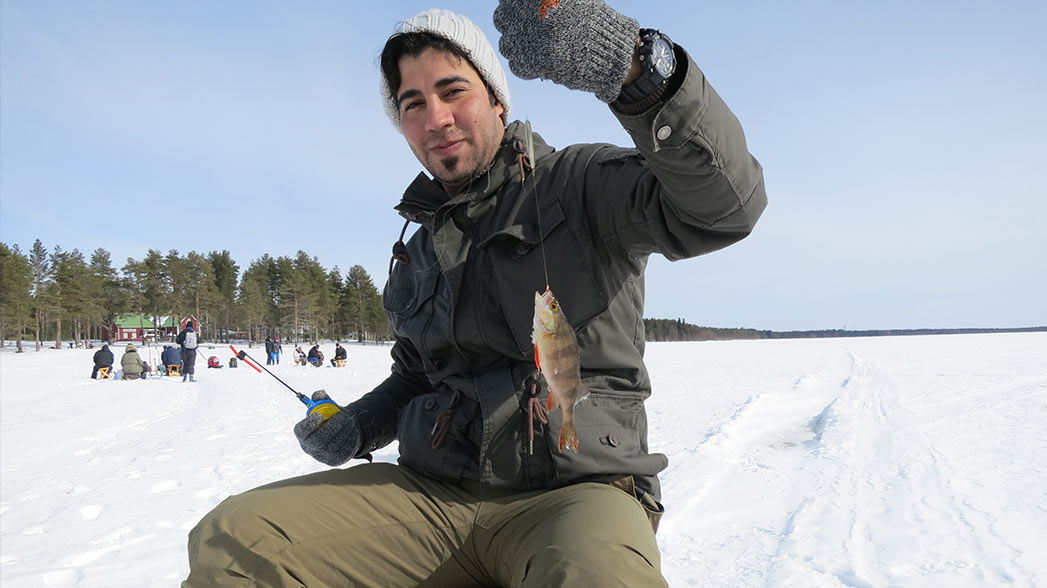Activities on Ice

Frozen lakes, rivers, and seas provide opportunities for activities that can only be experienced in wintertime—and when the ice is thick enough. Snowshoeing or walking around on a frozen lake and sliding on an ice-skating track are great ways to enjoy the beauty of winter in Finland’s natural areas. Snowshoeing is very easy on ice, where your path is very flat. For those, who are into sitting over a small hole in the middle of a frozen lake, sipping hot chocolate from a thermos every now and then, ice-fishing is a fantastic way to spend your winter day.
Temperature plays an important role in the freezing process. Therefore, ice is often not thick enough in early winter, at least not in the south where temperatures tend to be higher compared to the north. Years are different from each other. Just because it was okay on December 1st to go out on ice last year, doesn’t mean it’s going to be safe on the same date this year.
There is always to a certain risk involved when travelling on frozen lake ice, but remaining in safe areas and using common sense can take you a long way.
How to get started
Since moving about on ice is never 100 % safe and it is not always easy to judge the strength of ice, it’s a good idea to only use maintained and marked tour skating tracks. For ice-fishing, walking and snowshoeing on ice, only enter areas that you know for sure are safe. Outdoor service providers, National Park visitor centres, and local tourist offices are good sources of information.
Ice skates, ice fishing gear and other equipment can be rented from several outdoor service providers throughout Finland. In each National Park, Parks & Wildlife Finland has a variety of authorized partners that offer organized activities, gear rentals and outdoor services in the area. They have a cooperation agreement with Parks & Wildlife Finland and they are committed to the principles of sustainable nature tourism. We recommend using their services.

Important tips
When tour skating, take advantage of marked and maintained skating tracks. They can be found in some National Parks (see below).
If feeling insecure, consider taking a guided ice-fishing or snowshoeing trip with one of the outdoor companies in the area. Enquire for example about a night-time snowshoeing trip combined with aurora viewing or star-gazing. On lakes or sea there is usually less light pollution.
There are sometimes cross-country skiing trails made on lakes. Please do not walk or snowshoe on skiing trails.
Cracking ice may sound threatening, but isn’t necessarily dangerous. It often means that the ice is expanding and contracting, as the temperature changes.
If maintained by a private company, there might be a small fee to skate on a maintained skating track. Otherwise, no permit is required for moving about on ice.
No license is needed for ice-fishing.
Safety
First and foremost, make sure the ice is safe. Never step on a frozen lake or other frozen body of water unless you are absolutely certain that there is enough ice to support you. Ice thickness can vary, especially over moving water. Ice formed over flowing water or currents is often dangerous. Every year, usually early or late in winter, several people drown due to weak ice.
Winter weather in Finland can be extremely cold, windy and unpredictable. Bear in mind that daylight hours are limited in the winter. Wear proper clothing layers. Watch yourself and other members of your party for signs of hypothermia.
Make sure to wear warm and waterproof boots. When skating, wear warm and windproof clothes, as even a mild wind on a wide, open area like a big lake can be freezing. When you move fast, it makes you feel even colder.
Carry extra clothing, food, snacks, water, map and compass (and know how to use them), matches and headlamp. Keep everything in waterproof bags. Carry water in insulated bottles so it doesn’t freeze, or consider bringing warm drinks, such as tea or hot berry juice.
Don’t go on ice alone. Leave word about where you are going, by what route, and when you plan to return.
Know the basics of ice rescue technique and be prepared for breaking though ice. For skating on a frozen lake, bring ice safety picks. At least one person in the party should carry a rope and keep it attached to the waist belt. Other essentials in your safety gear bag include an ice spud, personal flotation device and a whistle.
Carry a fully charged mobile phone, in a waterproof bag. However, do not rely on it. Smart phones don’t always work in low temperatures so keep your phone warm. Note, that not all areas have cell phone coverage.
Emergency number in Finland is 112.
